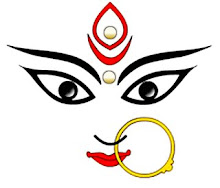 |
| Navarathri festival |
Navaratri is a festival that lasts nine days and nine nights. The word “Navaratri” actually means nine [Nava] nights [ratri]. This is celebrated in different styles throughout India. Navaratri occurs during the first 9 days of the bright half of the month of Aashwayuja in the Indian calendar. Navarathiri Pooja is not a pooja that is done only for one day. It is done for 9 days. Nava means “nine”. Since, the pooja is done for 9 days, the pooja is so called as “Navarathiri” Pooja. This pooja is mainly done towards the Goddess – Shakthi and she is the main deity for this pooja. This 9 days of pooja is segregated into 3 parts and each parts contains 3 days of each. Therefore, in these 9 days, first 3 days of pooja is for Sri Durga Devi, the next 3 days, pooja needs to be done for Sri Lakshmi and the final 3 days for Sri Saraswathi. Further one more day the pooja is extended and on that particular day, we have to do pooja for all these 3 deities
 |
| Doll Arrangement- "Kolu" |
The Navrathri or Dussehra kolu is displayed on stairs created from wood. The number of steps depends on the availability of the dolls. The maximum number is nine – representing the nine days of Navratri. Usually, the steps erected are even numbers – 1, 3, 5, 7, 9 or 11.
Kolu – the royal court of Goddess Durga is created 3, 5, 7, 9 or 11 steps.
 |
| Navarathri Decorations |
 |
| Marapachi Dolls-A must in every Kolu |
There are no hard and fast rules for arranging the dolls. Nowadays, the arrangement depends on the availability of dolls. In most places, the entire nine steps will be filled with statues of various gods and goddesses in Hindu pantheon. For some, the Navratri Kolu is a simple arrangement of various deities in three steps.
*The topmost three steps are dedicated to various gods and goddesses. In some areas, people place a ‘Purna Kumbham’ on the topmost step.
*The next three steps – 4, 5 and 6 – are dedicated to Gurus, saints, religious personalities and other highly respected figures in the country and world.
*The seventh step is dedicated to various social activities and festivals. People depict marriages and important festivals in this step.
*Business, crafts and other economic activities are depicted in the eighth step. Creative women depict a buzzing market place and other activities.
*The ninth step is dedicated to dolls made of wood. Dolls of men, women, children, animals and birds are placed in this step.
During Bommai Kolu, the entire neighborhood, friends and relatives gather in a house and sing bhajans dedicated to Goddess Durga. Special sweets are prepared during the period.
On the Vijayadashami day [the tenth day], the dolls are taken out.
 |
| Kalasham/Kumbam |
How to perform the rituals:
A Kalasham is prepared at home and the water is changed daily for nine days. The kalasham is placed on grains on raised platform or in the Puja room. Goddess Durga is worshipped during the first three days, Goddess Lakshmi for the next three days, and Goddess Saraswathi during the last three days. [Some people make clay figures of the Goddesses during the period].
Each day fresh flowers and fruits are offered to the Goddess. Arati is performed and bhajans are recited.
* Purna Kumbam or Kalasham is kept on a kolam in such a place that there is space behind to keep the Bommai Kolu. You can attach a face of Goddess to the Purna Kumbha and decorate the Kumbham with jewelry, turmeric, sandal paste, flowers etc.
* Those who do not keep Kolu, keep the Kalasham in the Pooja room.
* Betel leaves, Betel nuts, a coconut is placed in front of the Kalasham. Cooked rice or boiled and sweetened milk is kept as prasadam or neivedya in front of the Kalasha.
* This Kalasham is to be kept for next nine days – it symbolizes Goddess.
* A lamp is lit every evening and morning for nine days.
* Normal puja is performed. Other women are invited on any one of the evening.
* The first three days is dedicated to Goddess Durga.
* The next three days is dedicated to Goddess Lakshmi.
* The final three days is dedicated to Goddess Saraswathi.
* Fresh kolams are done on all nine days.
* Shlokas that are recited on nine days include Durga Ashtotaram, Devi Mahatmiyam, Shyamala Dhandakam, Lakshmi Sahasranama, Lakshmi Ashototaram, Lalitha Sahasranama, Saraswathi Stotram, Saraswathi Ashototaram.
* Sholakas are recited while performing the puja.
Sweets and neivedya prepared are shared with neighbors, relatives and friends The lamp is diffused after the puja daily.
On the Vijayadashami day [the tenth day], the dolls are taken out. after making them sleep.
"Navarathri Kolu` festival is celebrated in a very beautiful and colourful manner in all South Indian states. During this festival, a mini-exhibition of toys and dolls are set up in many Hindu homes. The origin of this unique festival is not known clearly but it is said that it existed at least for the past five hundred years i.e. from the days of the Vijayanagar kings of Hampi in Karnataka. The reference of the festival `Navarathri Kolu` is found in the inscriptions of these kings. The Tanjavur Maharaja Sarfoji`s Saraswathi Mahal Library old Marathi record mentions that dolls representing eighteen different castes were supplied at that time. This proves its antiquity. Even the royal families of the Tanjavur and Pudukkottai kingdoms of Tamil Nadu used to celebrate the `Navaratri Kolu` festival in a very grand manner.
The most surprising fact is that the `Navarahtri Kolu` festival is not confined to India only, it is also celebrated in many other Asian countries, mainly in Sri Lanka and Japan. In Japan, the `Navarathri Kolu` is known as `Hina Masturi`. During this festival they display beautiful Japanese dolls and miniature tableware in rows, exactly like the kolu in India. Whether it is in India or in any other country, `Navaratri Kolu` is mainly a ladies festival.
 |
| Kolu Bommai |
More on Bommai Kolu.
| The most popular Chettiar Bommai |
The preparation for the `Navarathri Kolu` festival starts months in advance. The `Kolubommai` or `kolu` dolls are tenderly wrapped in cotton rags, which are generally kept carefully in huge wooden trunks. So, during the preparation, the dolls are taken out with care, dusted, mended and given a fresh coat of paint if needed. Each `Navarathri Kolu` festival must have at least few new dolls. The creative housewives are given the responsibility to make new dolls every year. The new dolls replace the old worn-out ones and they are sold and purchased on the eve of the festival.
 |
| Dolls on Display in the busy Streets |
 |
| Shopkeepers selling Dolls for "Kolu" |
| Wedding Set on Display - Dolls made of Mud/Clay |
 |
| Thanjavur-Thalayatti Bommai |
 |
| Traditional Big Dolls |
 |
| Religious Set of Dolls-Ramar Set |
 |
| The Dasavatharam Set of Dolls |
The dolls used in the `Navarathri Kolu` festival are mostly huge mud icons of various gods and goddesses painted in bright colours. The dolls were made of rosewood, sandalwood and even by ivory in the rich families. A Ramayana set, a Dashavatara set, a set of musicians playing different instruments can be seen in almost all Kolus. The other things which can be noticed include the pot-bellied Chettiar and his equally fat wife, both smiling with their mouth wide open and in this the children often tries to feed the Chettiar by throwing grains of rice into his cave-like mouth.
 |
| Grand Kolu exhibitions |
But, luckily, few of the South Indian families in Indian and even in foreign countries have kept this age-old traditional festival alive. Few of the corporate houses also sponsor some local clubs and associations to organise kolu competitions during the Navaratri. Attractive prizes are also kept for the best kolu dolls.
Now, the present day `Navarathri Kolu` festival is just a miniature replica of the kolus of the olden days. There are many innovations and substitution can be seen in the Kolus of present day. As the earlier wooden Kolupadi have vanished, the iron Kolupadis are used now, which are available in few selected furniture shops. These Kolupadis are used as bookshelves after the `Navaratri Kolu`. Some other creative people also make kolu steps out of big boxes and outsized dictionaries. The white and red cloth covers of the steps are replaced with plastic sheets or paper. Even the dolls of gods and goddesses are also replaced by the dolls adorned with the traditional costumes of the different states of India and the different countries of the world. Most of the NRI families use the dolls of the airhostess. Other three popular dolls include the dolls representing the postman with his kakhi uniform and mailbag, the doctor with his stethoscope and the shopkeeper with his wares.
With the coming of technology, the designer Kolus are also made during the `Navarathri Kolu` festival. Apart from the dolls, these kolus also exhibit colourful books including pop-up books and bath books, stamps, coins, medals, paintings, charts, children`s toys and games. The Kolu room is also decorated with the help of computer graphics. Even the floor decoration process has seen many new innovations like in place of the village scenes and temples; the events from the not-too-distant past are made as the theme. For example, the general elections, the Kargil war and the Olympic Games are presented through various models and figures and with the use of thermocol and cotton.
 |
| "Thematic Kolu" -Innovative Scenes from the Ramayana |
Now, in this era, people join together and make a kolu with others in a common place; generally their workplace or it may be in any community hall or departmental store. These promote the team spirit and reflect the collective talent and imagination of the community.
The most significant part of Navarathri besides setting up of "Golu", Navarathri is never complete without the different kinds of sundal made each evening.
For Sundal Recipes, you may view my below links:
Right from con-ceptualising to arranging the dolls by giving attention to minute details and involving the whole family, is what Navaratri is all about for some people who want go an extra mile.
 |
| Goddess Saraswathi--Durga--Lakshmi |
 |
| Navrathri Celebrations-"Garba Dance" |
Navratri, meaning 'nine nights', is one of the most popular and widely celebrated Hindu festivals in many parts of India. Gujarat, however, is the only state that erupts into a nine-night dance festival, perhaps the longest in the world. Each night, all over the state, villages and cities alike, people gather in open spaces to celebrate feminine divinity, referred to as Shakti.
 |
| The Folk Dance joined by the Dandiya |
The children enjoy this Navarathri Kolu` festival the most as it becomes like a nine-day crash course on hard work, discipline and courtesy. They work with joy and keep the kolu room clean and neat throughout the festival. They eagerly invite and welcome the guests and show them the Kolu and the models prepared by them.
 |
| Navarathri Gifts |
Arranging Navrathri Kolu is also an event in itself it means inviting neighbors, friends and other relatives to visit your home and view the Kolu decorated. Pleasantries and small gifts are exchanged amongst women generally women exchange coconuts, cloths and sweets amongst themselves. Sumangali [married] women also exchange bags containing a small mirror, turmeric, comb, beetle leaves with beetal nut.



























